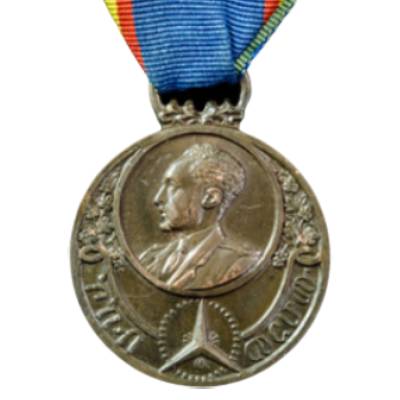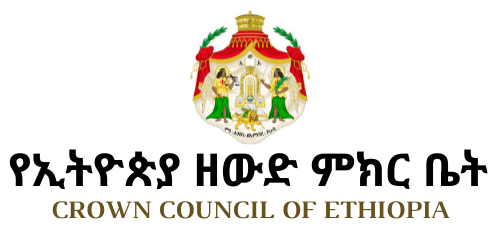
The Refugees’ Medal was created by Emperor Haile Selassie I during or following the Italian invasion of Ethiopia (1935-1941), and was intended to acknowledge those who had assisted the enormous number of refugees which that war created. The first Duke of Harar was actively involved in repelling the Italians and worked strenuously to assist the Ethiopians displaced by the war, and was, as a result, awarded the Refugees’ Medal no less than five times.1HIH Makonnen, Duke of Harar: Life & Records. 1957, Addis Ababa.
The Refugees’ Medal is a bronze circular medal about 35mm in diameter, showing on its face Emperor Haile Selassie I, bareheaded, in a circle above the three-pointed Trinity star (sometimes called the Bethlehem star), with an inscription in Amharic on each side. The date “1935” is shown on the obverse, along with the words in Amharic: “The star led them”. The reverse shows five lines of Amharic: “Hope established in faith is a proven instrument of victory”. The riband is a bright, dark blue with the Ethiopian tricolour of green, yellow and red running narrowly down each side, with the green outermost.2Medal in the author’s possession.
Subsequent awards of the medal to the same recipient are indicated by the addition of a bronze palm leaf across the riband. The medal is a current decoration within the Crown’s gift, although no recent issuances have been made of it. Given the refugee problems caused by the coup d’etat of the Dergue in 1974, and the subsequent civil war and the 1998 war with Eritrea, the Crown Council feels that it would be appropriate to re-issue the Refugees’ Medal to recognise recent outstanding efforts on behalf of displaced peoples.3Statement by HIH Prince Ermias Sahle-Selassie Haile-Selassie, President of the Crown Council, to the author in private interview, June 1998. The medal carries no post-nominal initials.


